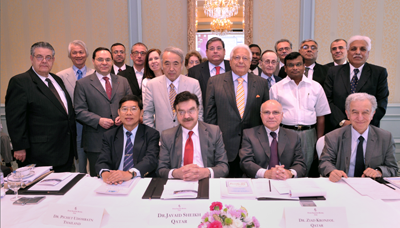Psychiatric workshop looks at creating a more culturally relevant curriculum
May, 2012

Dr. Javaid Sheikh, Dean of WCMC-Q, and Dr. Ziad Kronfol,
Professor of Psychiatry, with the other delegates.
The West differs from the Middle East in many ways – culturally, ethnically, religiously and even genetically.
Yet the psychiatric model used to assess and treat patients with mental illness in the region was developed by and for a primarily Anglo-Saxon population based in the United States and Western Europe.
Weill Cornell Medical College in Qatar’s (WCMC-Q) workshop Undergraduate Psychiatric Education in Developing Countries; Towards a more Culturally Relevant Curriculum, aimed to address those discrepancies, bridge the gap between developed and developing countries and also discuss how undergraduates should be trained to best serve the mental health needs of the population in this region.
The conference was organized and hosted by Dr. Ziad Kronfol, Professor of Psychiatry at WCMC-Q, in collaboration with the Asian Federation of Psychiatric Associations and with co-sponsorship from the World Psychiatric Association.
Dr. Kronfol said: “The point of this workshop was to come up with a psychiatric curriculum that is more relevant to the region. We want our doctors to be able to confidently deal with mental health issues found in this part of the world.
“We have a large immigrant population in Qatar and in the wider region there are refugees and people displaced by wars and conflicts. In other parts of Asia there are higher occurrences of natural disasters like earthquakes and tsunamis. The psychiatric model we import from the West does not necessarily deal with those types of problems. So we invited psychiatrists from developing and developed countries to enrich our mental health program and make it more sensitive and relevant to the inhabitants of this region.”
Guests at the workshop included Dr. Pedro Ruiz, President of the World Psychiatric Association (WPA), who said that the Western psychiatric model currently employed is now even defunct in the countries where it was created. Developed with an Anglo-Saxon population in mind, the model is of little use in the United States, which is now a melting pot of nationalities.
He said: “World-wide we are not all the same, we may have similarities but people react differently to different medication.”
In all 15 experts from across the world were invited to contribute to the conference and of particular resonance for WCMC-Q was the discussion on how the curriculum could be tweaked to ensure that graduating doctors are best able to take care of their patients’ psychiatric needs.
Professor Ahmed Okasha, President of the Egyptian Psychiatric Association and a past president of the WPA, said that between 70 and 80 per cent of psychiatric patients are seen by their general practitioner so it is vital that those doctors are aware of the treatments but also the cultural differences of the population they are serving. If this can be done the huge burden placed on society due to mental health issues can be relieved.
“Culture is the matrix of any education so you can’t teach students unless you assimilate their education with the local culture,” Professor Okasha said. “I see patients from all over the Gulf region and usually they say they have been for traditional healing before coming to you as they thought it was an evil eye or magic, both of which are firm beliefs in this culture.”
Professor Okasha said that understanding this and other local cultures was vital for a psychiatrist to be able to effectively deal with a patient.
The workshop ended with various recommendations being formulated, some universal and some specific to countries in this region.
Among the universal recommendations was the need to stress the bio-psychosocial model of mental illness and the need to assess the attitudes and skills of the medical student in addition to his/her knowledge during the psychiatric rotation.
Specific to countries with limited resources was the importance of using other methods of teaching besides lectures like videos, group work and e-learning. When manpower is limited then senior students and resident physicians could also participate in the teaching process.
